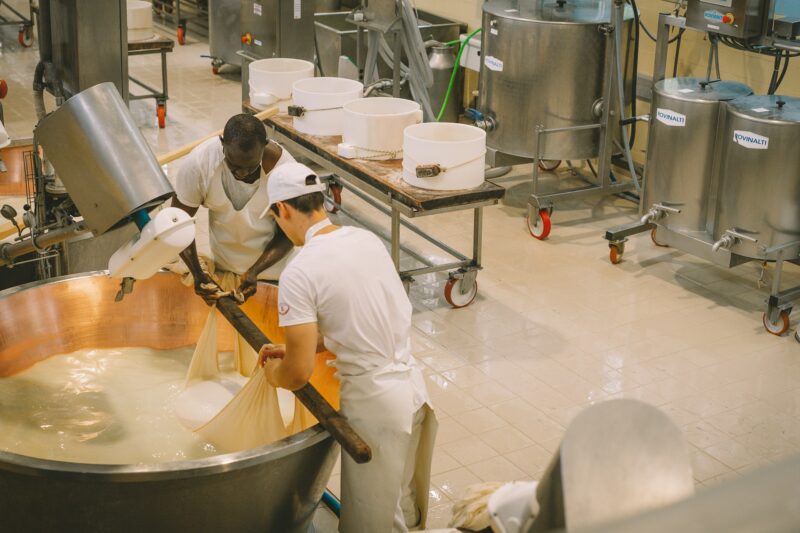Preparing Your Business for a Food Safety Inspection
A food safety inspection can feel daunting, but it doesn’t have to be. With proper preparation, you can ensure compliance and pass inspections with ease. This guide outlines practical steps to get ready for a food safety inspection, helping you maintain confidence and safeguard your business.
Whether you’re part of one of the larger CPG companies or you run a smaller operation, following these steps will help you meet food regulation standards and keep your customers safe.
What to Expect During a Food Safety Inspection
Before preparing, it’s essential to understand the purpose and structure of a food safety inspection. Inspectors are tasked with ensuring that your facility meets government food regulation requirements, prioritizing the safety and quality of your products.
Common Areas Reviewed
- Storage Areas: Checking for proper storage temperatures, cleanliness, and organization.
- Production Lines: Evaluating hygiene practices and machine maintenance.
- Employee Practices: Ensuring staff are trained in compliance tips such as hygiene and handling safety.
- Documentation: Reviewing records like quality control logs, cleaning schedules, and ingredient sourcing.
Understanding these focuses can shape how you plan for an inspection.
Steps to Prepare for a Food Safety Inspection
Preparation is key to passing a food safety inspection and maintaining customer trust. Here’s a practical inspection checklist to guide you.
Maintain a Clean Facility
A clean facility is non-negotiable. Establish and maintain regular cleaning schedules, ensuring all areas—from storage rooms to production lines—are spotless.
- Daily Cleaning Tasks:
- Sanitize surfaces and equipment.
- Disinfect high-contact areas like door handles, switches, and packing counters.
- Weekly Deep Cleaning:
- Address hard-to-reach places.
- Remove buildup from production machinery.
- Monitoring:
- Document all cleanings in your compliance logs as proof during inspections.
A consistently clean space will reduce risks and demonstrate your commitment to hygiene standards.
Train Your Team on Food Safety Protocols
Your employees are your first defense during an inspection. All staff should understand proper food handling protocols relevant to their roles.
- Regular Training Sessions:
- Offer quarterly workshops to review updates on the latest food regulation standards.
- Clear SOPs:
- Provide detailed standard operating procedures (SOPs) for all tasks, from product handling to waste disposal.
- Team Drills:
- Run mock inspections to identify weaknesses and reinforce critical compliance tips.
Well-trained teams not only enhance safety but also reflect positively during evaluations.
Streamline Your Documentation
Organized documentation is crucial for passing food safety inspections. Ensure all compliance-related documents are accurate and easy to access.
- Records You Need:
- Cleaning schedules.
- Food safety certificates.
- Inspection checklist history.
- Supply chain documentation.
- Digital Systems:
- Invest in food safety management software to centralize these records digitally.
- Routine Updates:
- Review and update logs weekly to keep them audit-ready.
Digitally managing your records simplifies inspections and significantly reduces paperwork errors.
Ensure Equipment is in Top Condition
Properly functioning equipment is vital to maintain sanitary production conditions.
- Routine Maintenance:
- Schedule monthly equipment checks to identify and address wear and tear.
- Calibrations:
- Annually calibrate tools like thermometers and scales.
- Repair Logs:
- Keep a log of all repairs and improvements as evidence of compliance.
Efficient equipment not only streamlines operations but also reduces inspection penalties.
Conduct Internal Audits
Performing regular internal audits mimics official inspections and reveals any gaps before actual evaluations.
- Checklist Customization:
- Develop an internal inspection checklist tailored to your specific processes.
- Cross-Department Audits:
- Have managers from other teams evaluate your areas for impartial oversight.
- Follow-Up Action Plans:
- Post-audit, address deficiencies with documented action steps.
Regular audits align staff accountability with organizational safety goals.
Foster a Culture of Food Safety
Food safety shouldn’t just be a compliance goal but part of your company’s culture.
- Leadership Buy-in:
- Ensure executives value and invest in food safety initiatives.
- Employee Engagement:
- Incentivize employees for safety goals met during internal inspections.
- Communication Loop:
- Regularly share safety achievements and areas of improvement during team meetings.
A strong safety culture empowers your team to prioritize safety even beyond inspections.
Addressing Common Challenges
Some aspects of preparation can be challenging, especially for resource-limited operations. Here are tips for overcoming the most frequent hurdles:
- Lack of Time for Inspections:
- Dedicate one day per quarter for thorough readiness checks.
- Complex Regulations:
- Partner with consultants or use software to interpret specific food regulation protocols.
- Employee Turnover:
- Incorporate food safety into onboarding for faster employee competence.
Mitigating challenges ensures your business stays resilient in the face of increasing regulatory standards.
The Importance of Staying Proactive with Food Safety
Passing an inspection isn’t just about keeping the regulators happy; it ensures your business operates ethically and prioritizes customer well-being. From small local brands to global CPG companies, proactive safety measures are a hallmark of successful food businesses.
By following these practical steps, you can master the art of inspection preparedness, protect your reputation, and boost consumer confidence.

